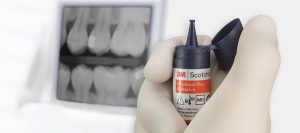Preserve and protect
Featured Products Promotional FeaturesPosted by: Dental Design 20th January 2021

In recent years, the shift in focus from restoration to prevention has meant big changes to the way that professionals approach treatment. From a greater onus being placed on oral care routines, to a wider use of fluoride varnishes and other shields against decay, today the goal is to stop caries before they even begin to form.
However, what about high risk patients who are prone to caries, or patients already with restorations looking to have these replaced or repaired? With these patient groups in mind, there is also the need for preservation as well as prevention.
Damaged dentition
It is estimated that as many as 90.2% of all adults in the UK population have a filling.[i] Furthermore, some estimates state that 75% of British adults do not have all of their natural teeth.[ii]
In many ways this makes sense – it is only recently that the dental profession has started to explore prevention, and for years there was more of a “drill and fill” approach in the industry, especially as this was believed to be the most beneficial way forward. It’s also worth remembering that past treatments for caries were much more invasive than they can be today.
It’s common knowledge that filled teeth are weaker than the natural dentition, and this means that these areas are prone to needing further attention as time goes by. These patients may, therefore, require extra protection should a filling need to be replaced, especially as the tooth is vulnerable already.
There are also high-risk patients to consider.
High risk patients
There are multiple reasons why a patient may be at a higher risk of forming caries. Certain physical and mental disabilities, for example, may prevent patients from brushing their teeth with the necessary amount of care. Another example could be patients who have a disease that makes them more prone to caries in the first place, like diabetes. Diabetics tend to be at greater risk of tooth decay because they have higher blood sugar, meaning they typically have more sugars and starch in the mouth that plaque bacteria can feed on.[iii]
Patients with eating disorders are also at higher risk of caries, especially those who purge as part of their disorder. This is because stomach acid weakens teeth, wearing away the enamel and leaving the teeth fragile and unable to defend against the acids created by plaque. Excess tooth-brushing after vomiting may put these patients at even higher risk of decay as the enamel can be worn away. Patients suffering from anorexia may also experience higher rates of caries due to the lack of nutrition.[iv]
In addition, we need to consider that some patients simply don’t put as much effort into their oral health routines as they should. Professionals will have all had patients who refuse to floss regularly or who continually struggle to implement proper oral hygiene advice, and these patients are likely to benefit from preservative measures.
Minimising future damage
 If a patient in one of these high-risk groups does present with caries, it’s important to restore and protect their dentition and take what measures you can to preserve the rest of their teeth. By doing so, you can help them to avoid the need for more invasive and expensive treatment. You can also take this approach when treating patients who want or need a filling replaced, especially if the tooth has been heavily restored before.
If a patient in one of these high-risk groups does present with caries, it’s important to restore and protect their dentition and take what measures you can to preserve the rest of their teeth. By doing so, you can help them to avoid the need for more invasive and expensive treatment. You can also take this approach when treating patients who want or need a filling replaced, especially if the tooth has been heavily restored before.
Fluoride has been proven to help prevent tooth decay,[v] so using restorative products that contain fluoride is a good first step. Fluoride-releasing materials, in particular, are a smart choice as many of them continue to release fluoride for months after placement. Your dental adhesive, too, should provide an effective bond, even on caries affected dentine.
The new Scotchbond Universal Plus Adhesive from 3M Oral Care has been specifically formulated to work just as well on caries affected dentine as it does on sound dentine. It also seals caries affected dentine to produce a well-defined, void-free hybrid layer – perfect for protecting against secondary decay.
Protect your patients
As dentistry continues to evolve and advance, it’s essential that dentists follow suit. The shift to prevention is a great start, but as some patients will still be prone to caries regardless, preservation is also key. By investing in products that help to achieve these goals, you can ensure that your patients are receiving the best care possible.
For more information, call 08705 360 036 or visit www.3M.co.uk/Dental
3M representatives continue to be available via video calling technologies for your convenience.
3M and Scotchbond are trademarks of the 3M Company.
Author John Rafelt
After finishing his PhD in Chemistry in 1999 at York University, John worked as a food analyst at the Government research laboratories and an advisor on research funding working closely with the European Commission. John joined 3M Espe in 2002 and is currently Scientific Affairs Manager for the 3M Oral Care UK and Ireland region. John lectures widely on advancements in dental materials and regularly writes articles on the same topic for the dental press.
[i] Statista. Share of Adults With At Least One Tooth Filling in the England in 2018, By Region. Link: https://www.statista.com/statistics/1131889/adults-with-tooth-fillings-in-england-by-region/ [Last accessed November 20].
[ii] Dentaly. Interesting Facts About Teeth and UK Dental Statistics. Link: https://www.dentaly.org/en/dental-facts-statistics/ [Last accessed November 20].
[iii] Mayo Clinic. Diabetes and Dental Care: A Guide to a Healthy Mouth. Link: https://www.mayoclinic.org/diseases-conditions/diabetes/in-depth/diabetes/art-20043848 [Last accessed November 20].
[iv] NEDA. Dental Effects of Eating Disorders. Link: https://www.nationaleatingdisorders.org/dental-complications-eating-disorders [Last accessed November 20].
[v] ADA. The Superhero That Lives Inside Your Mouth. Link: https://www.mouthhealthy.org/en/fluoride-superhero [Last accessed November 20].









